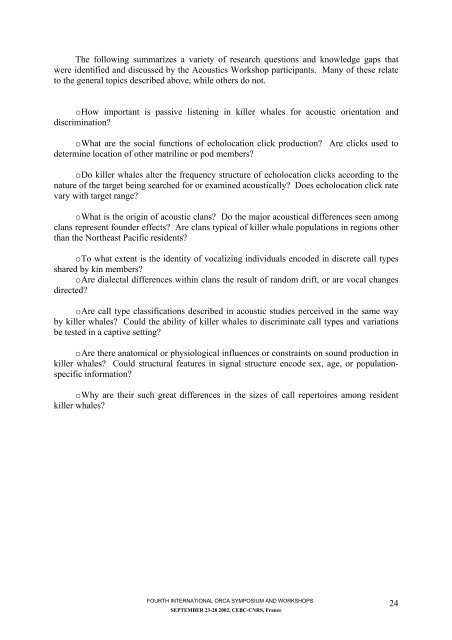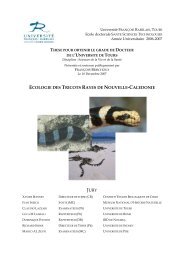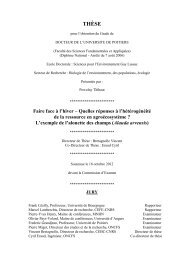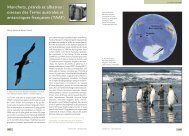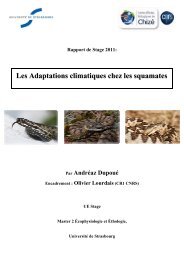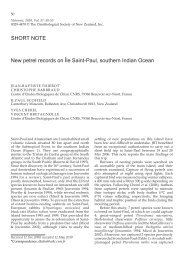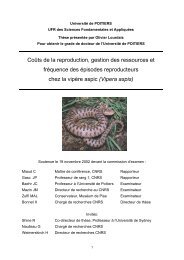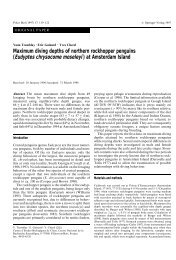- Page 1 and 2: Fourth International Orca Symposium
- Page 3 and 4: Anatomy of a Long-term Study: Popul
- Page 5 and 6: KILLER WHALE WORKSHOP - FORAGING EC
- Page 7 and 8: (including crittercams) and high-fr
- Page 9 and 10: The way prey avoids killer whale pr
- Page 11 and 12: KILLER WHALE WORKSHOP - CONSERVATIO
- Page 13 and 14: • Are killer whales opportunistic
- Page 15 and 16: 6. Lack of Governance The wise appl
- Page 17 and 18: Appendix 1 Top 3 threats to killer
- Page 19 and 20: KILLER WHALE WORKSHOP - ACOUSTIC Pa
- Page 21 and 22: lowest band, and burst-pulsing can
- Page 23: the presence of killer whales throu
- Page 27 and 28: that resident killer whales have bo
- Page 29 and 30: Bigg also used the alphanumeric sys
- Page 31 and 32: Stevens, T.A., D.A. Duffield, E.D.
- Page 33 and 34: population but that have markedly d
- Page 35 and 36: KILLER WHALES AT MARION ISLAND, SOU
- Page 37 and 38: watching from shore based vantage p
- Page 39 and 40: Frequency of occurrence (%) 5 4,5 4
- Page 41 and 42: Great White Shark (north of Montere
- Page 43 and 44: white shark attack 1997 40° 30° 8
- Page 45 and 46: KILLER WHALES (ORCINUS ORCA) OF ALA
- Page 47 and 48: sightings for RJ were obtained from
- Page 49 and 50: Figure 1. Sightings (o) and strandi
- Page 51 and 52: RESULTS AND DISCUSSION Sightings Ov
- Page 53 and 54: Fig. 2 - The overall gray pigmentat
- Page 55 and 56: average click sounds with 51 clicks
- Page 57 and 58: THE BC CETACEAN SIGHTINGS NETWORK:
- Page 59 and 60: VOCAL BEHAVIOUR OF TRANSIENT KILLER
- Page 61 and 62: Call rate (calls per individual per
- Page 63 and 64: MIRROR IMAGE PROCESSING IN KILLER W
- Page 65 and 66: ANALYSIS OF THE DISCRETE CALLS OF K
- Page 67 and 68: REFERENCES Ford J.K.B. Call traditi
- Page 69 and 70: IS KILLER WHALE (ORCINUS ORCA) BEHA
- Page 71 and 72: localize the vocalizations of indiv
- Page 73 and 74: A total of 16 pods were described f
- Page 75 and 76:
BEHAVIOURAL AND ACOUSTIC DIFFERENCE
- Page 77 and 78:
ANALYSIS OF PHOTO-IDENTIFICATION DA
- Page 79 and 80:
Overall, there is some evidence for
- Page 81 and 82:
ASSESSING THE IMPACTS OF KILLER WHA
- Page 83 and 84:
WORLD-WIDE GENETIC DIVERSITY IN THE
- Page 85 and 86:
COOPERATIVE HUNTING AND PREY HANDLI
- Page 87 and 88:
Using this method established by Bi
- Page 89 and 90:
SURFACE INTERVALS OF AN ADULT MALE
- Page 91 and 92:
VARIABILITIES IN SURFACE INTERVALS
- Page 93 and 94:
The lack of understanding of transi
- Page 95 and 96:
ANATOMY OF A LONG-TERM STUDY: POPUL
- Page 97 and 98:
Blubber from biopsy samples were an
- Page 99 and 100:
km from southeastern Alaska, south
- Page 101 and 102:
Most large whale kills from Mexico
- Page 103 and 104:
Figure 1 FOURTH INTERNATIONAL ORCA
- Page 105 and 106:
UNRAVELING THE INFLUENCE OF SOCIAL
- Page 107 and 108:
On the basis of these reported sigh
- Page 109 and 110:
KILLER WHALES (ORCINUS ORCA) IN AUS
- Page 111 and 112:
Southern Oceans Orca Database The S
- Page 113 and 114:
evidence that it had ingested piece
- Page 115 and 116:
Figure 1. Distribution of killer wh
- Page 117 and 118:
LIFE HISTORY AND POPULATION DYNAMIC
- Page 119 and 120:
The population model predicted that
- Page 121 and 122:
LIFE HISTORY AND DECLINE OF KILLER
- Page 123 and 124:
and Otto’s and Generalised Remova
- Page 125 and 126:
killer whale concentrations in Prin
- Page 127 and 128:
TOXICOLOGICAL EFFECTS OF TOXIC CHEM
- Page 129 and 130:
3. Barrett-Lennard,L.G. 2000. Popul
- Page 131 and 132:
THE BIOLOGY AND STATUS OF AN ENDANG
- Page 133 and 134:
MATCHED VOCAL EXCHANGES OF SHARED S
- Page 135 and 136:
The total number of good quality lo
- Page 137 and 138:
AERIAL VOCALISATIONS OF KILLER WHAL
- Page 139 and 140:
Pilot Whales (Globicephala melas),
- Page 141 and 142:
FIG.1: Research Area FIG.2: Aleator
- Page 143 and 144:
THEODOLITE STUDY OF THE EFFECTS OF
- Page 145 and 146:
FOURTH INTERNATIONAL ORCA SYMPOSIUM
- Page 147 and 148:
Southeaster n Alaska Study Figure 1
- Page 149 and 150:
ENCOUNTERS 5 4 3 2 1 0 SEP OCT NOV
- Page 151 and 152:
WHAT IS THE FAVOURITE PREY ? FORAGI
- Page 153 and 154:
1998, Hoelzel et al. 1998, Matkin e
- Page 155 and 156:
LITERATURE CITIED Bain, D.E. 1989.
- Page 157 and 158:
een an observed attack on Northern
- Page 159 and 160:
percent number of sightings 16 14 1
- Page 161 and 162:
also analyse earlier recordings obt
- Page 163 and 164:
Thomsen, F., Franck, D. and Ford, J
- Page 165 and 166:
A REVIEW OF SHORT- AND LONG-TERM EF
- Page 167 and 168:
question of whether whale watching
- Page 169 and 170:
values of all possible pairs of wha
- Page 171 and 172:
Bigg, M.A, Ellis, G.M., Ford J.K.B.
- Page 173 and 174:
Figure 2. Cluster tree of associati
- Page 175 and 176:
RESULTS: A total of 55 echo-sounder
- Page 177 and 178:
Figure texts for the summary of: "N
- Page 179 and 180:
The Orca Survey staff has accentuat
- Page 181 and 182:
Travel formation in relation to num
- Page 183 and 184:
NEW ZEALAND ORCA Visser I.N. Orca R
- Page 185 and 186:
Visser, I. N. (2000). Orca (Orcinus
- Page 187 and 188:
~ Some Antarctic killer whales have
- Page 189 and 190:
FIRST PHOTO-IDENTIFICATION MATCHES
- Page 191 and 192:
variable calls was significantly hi
- Page 193 and 194:
whales, rather than providing infor
- Page 195 and 196:
Figure 1. Predicted density of kill
- Page 197 and 198:
Probability Randomly choose paramet
- Page 199 and 200:
WHY DO SOME KILLER WHALES TALK SO M
- Page 201 and 202:
Figure2: Spectrographic examples of
- Page 203 and 204:
Deecke, V. B., J. K. B. Ford, et al
- Page 205 and 206:
Secchi, 47 Shapiro, 136 Sigurjonsso


